Toxic Treadmill
Evidence for a Poisoned Planet
About Toxic Treadmill
Insanity in individuals is something rare, but in groups, parties, nations, and epochs, it is the rule.
Friederich Nietzsche
Toxic Treadmill was created by Peter Jorgensen (BSc, MA) to help bring a more rounded view of the breadth and depth of the poisonous nature of contemporary society. This isn't about a single issue, something pushed too hard by science and the media. Nor is it about the need for technological fixes, many of which simply bring new problems. Instead, Toxic Treadmill stands to illustrate a common thread between a multitude of harmful issues. What humanity needs to address, should it wish to survive, is a cyclical pattern of dysfunctional behaviour. An innate impulse that is driven to extremes by modern socio-economic norms and expectations, underpinned by a bizarre and irrational cult mindset. Politics of all flavours is infested with the sickness. When any genuine challenge to the established order shows promise, the zombie horde is directed to attack, often believing they're supporting change. Hope can feel good, but when it's used to evade staring down the beast, it makes things worse. The likelihood is that things will continue to degrade, and it's best that people prepare for that. The most important thing for any individual is to understand themselves as deeply, thoroughly, and broadly as possible.
Everyone knows that the world is beset by environmental problems. Yet, many continue to ignore the issues we are swamped with. Others complain about environmentalism, as though it was a minor inconvenience; like eating food, and breathing. Yet, they're just as likely to do a fundraiser for cancer research when they lose someone they love, failing to see the connection between environmental issues and their loss. The world order has continuously ignored its immoral and irresponsible approach to profiteering (for themselves), racking up a record financial deficit (for others), and causing a tsunami of sickness (for all). Somehow, they've managed to brainwash whole herds of people into thinking that virtuous behaviour includes greed, reckless development, borrowing from a future that can't pay, and destroying other people's health and wellbeing. Why would anyone defend an ideology that has demonstrably caused so much harm? For example, irreversible damage to the environment and people's lives, increased chronic physical and mental illness, and proliferation of the global slaughterhouse of war and conflict. And, all this, at the cost of a monstrous increase in public and private debt.
A Blinkered Economy
Narrow focus is endemic. Few people understand human development from an ecological and planetary perspective, preferring to zoom in on the tiny slithers of time either side of their own existence. This microscopic focus on minutiae blocks awareness of our development and behaviour as a species. In other words, it prevents a more robust understanding of what it means to be human, and what we are doing versus what we think we're doing. Such blinkered vision favours those who steer the behaviour of the mass of humans, but what are their motives? The evidence doesn't present a positive picture. That isn't negative thinking, it's facing reality. The truth is that the cumulative, lasting effects of innovation continually prove to be harmful in ways nobody appears to have envisaged.
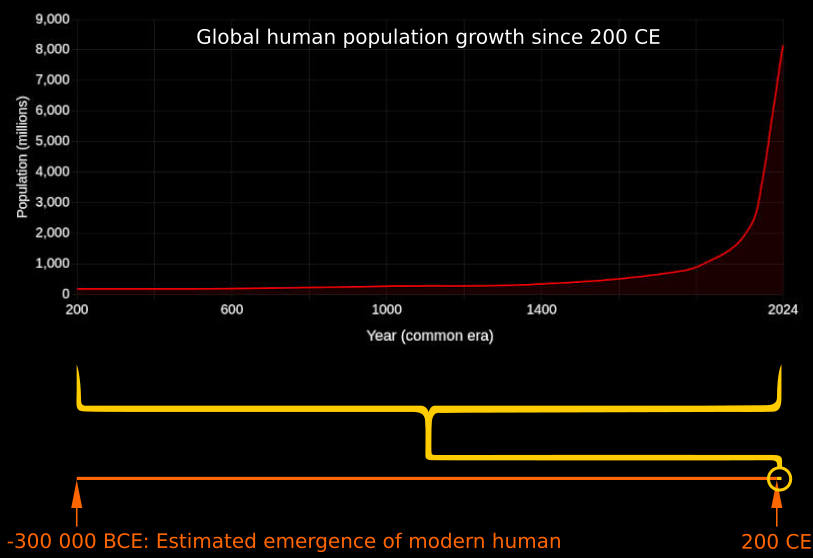
Homo sapiens is the last remaining species of the genus Homo. All former species from this genus are extinct. For tens of thousands of years, our global population never exceeded a peak of around 10 million. This is 800 times fewer people when compared with today. The bulk of this massive explosion in numbers occurred over the last few hundred years; a mere slither of the total time the species has existed, which is estimated at around 300 000 years. In the context of life on earth, 300 000 years is an extremely short period. If the total time Homo sapiens existed on the planet was marked on a line, where a single pixel equalled 300 000 years, you would need 23 662 monitors with a horizontal resolution of 1920 pixels, to show the full line. If these monitors were laid end to end, and had a width of 24 inches, they would extend to around 15 km. One single pixel at the end would represent the entire existence of humankind (that pixel would represent the same period of time that the orange line on the chart above represents). For most of that pixel, modern economics did not exist. The red line on the chart above spans 1800 years; it's just over half a percent of that single pixel.

Metabolic Throughput & Waste Production
Life is a metabolic process. Bodies are biochemical processing units. The materials we consume are converted to energy and other substances designed to maintain the factory. From this activity comes waste. We expel this regularly, every day. Human societies are no different, just operating at a larger scale. Ingredients are gathered, converted, shaped, and put to use. The intention being to benefit the bodies and assist them in their own maintenance and metabolism. Just as individual bodies produce excrement, so do factories, towns, cities, nations, and continents. As populations increase, so does their junk, garbage, debris, and effluent. Due to developing a recent addiction to material growth, the crap that humans produce doesn't just increase with each new individual. In the 'developed' and 'developing' world, each individual is also pushed to 'grow', so the crap they create in the process will increase too. This results from the insane hegemonic ideology of growth-based economics. Below, you can see the outcome of adopting a pathological worship of growth; nothing more than the deification of a metabolic process that aims at harvesting energy for self-replication. Even viruses adhere to that religion.
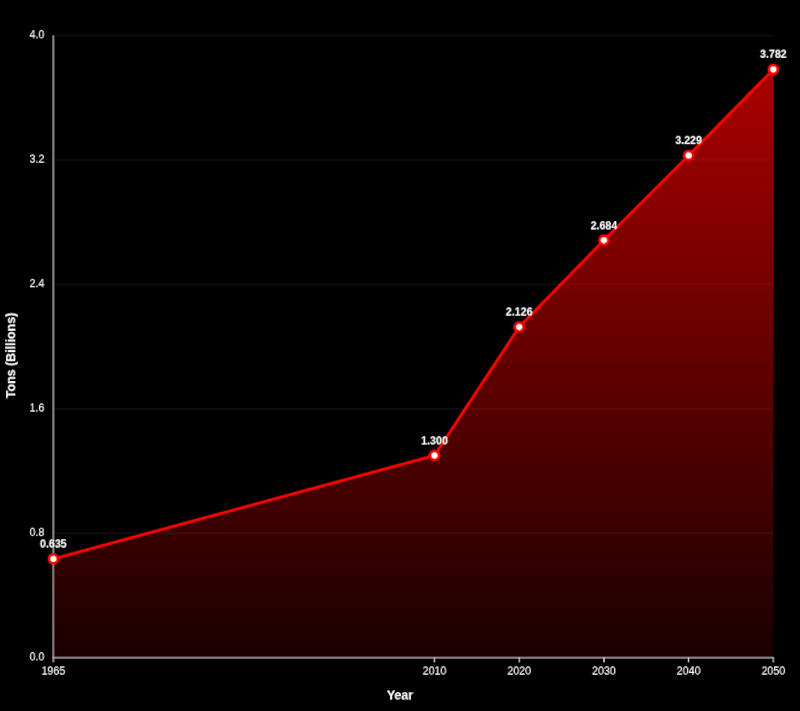
Chen, D. M. C., Bodirsky, B. L., Krueger, T., Mishra, A., & Popp, A. (2020). The world’s growing municipal solid waste: trends and impacts. Environmental Research Letters, 15(7), 074021.
Hoornweg, D., & Bhada-Tata, P. (2012). What a waste: a global review of solid waste management. Washington: World Bank
United Nations Environment Programme, & International Solid Waste Association. (2024). Global waste management outlook 2024: Beyond an age of waste – Turning rubbish into a resource (Technical report). Nairobi: United Nations Environment Programme.
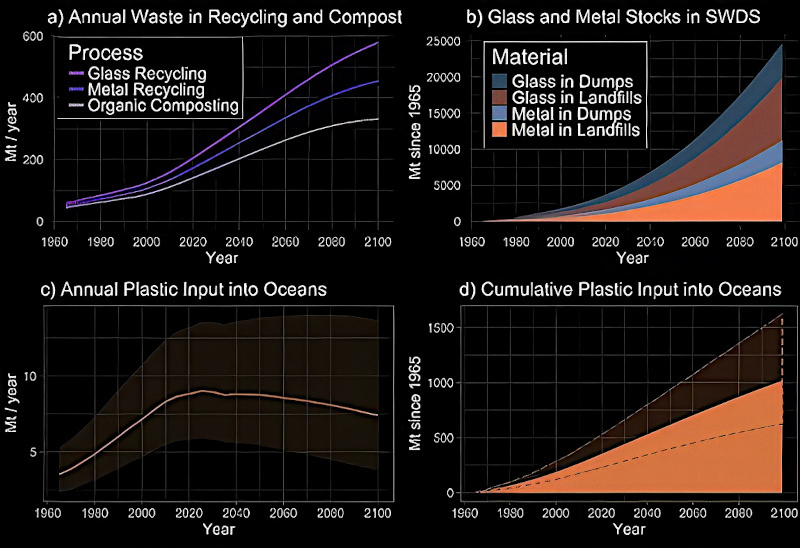
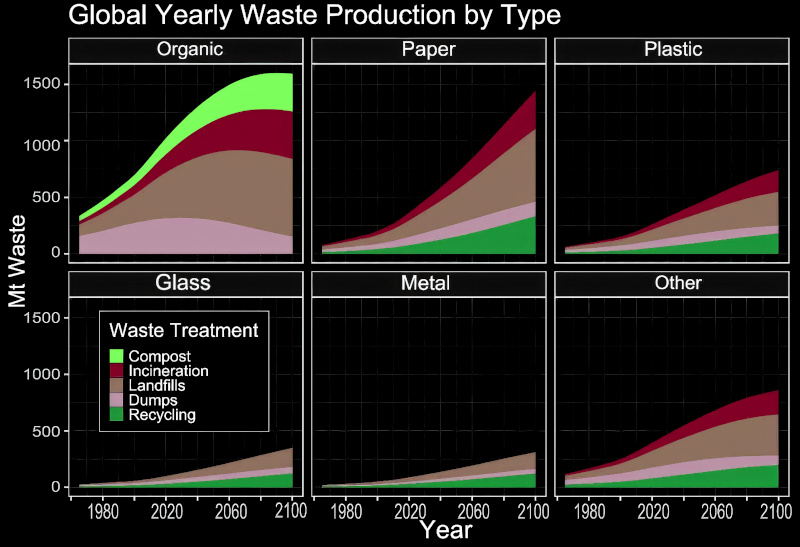
The Brazen Bullshit of Growth Economics
There are many mystifying things about growth economics. Its sheer lack of meaningful purpose, its irrational foundations, and the perpetual dishonesty used to support it are three of the most obvious. One profound lie of recent times is that more people is a good thing, without which the economy will suffer. Of course, the economy doesn't exist, people do. So, really, the implication is that people will suffer. However, along with the growth in population, global debt has increased, not reduced. In fact, when adjusted for inflation, or measured on a per capita basis, global debt has got worse across the board, hitting an all-time high in 2024, and again in 2025. Based on the evidence, more people will only add a disproportionate amount of debt. I wonder, could those responsible for spreading this propaganda benefit from debt? Or, perhaps, an inexhaustible supply of disposable labour, and lots of sick people to sell health services to?
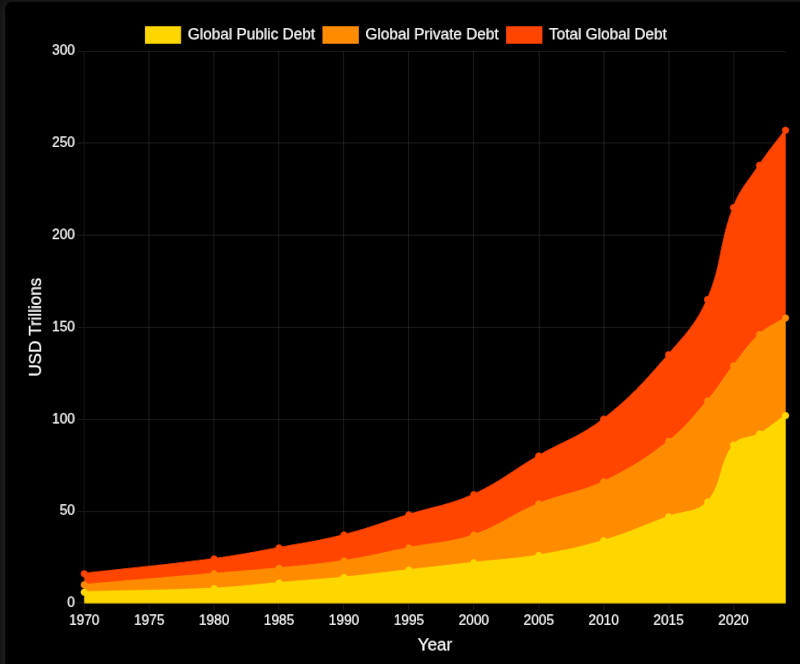
Bank of International Settlements. (2023, June 12). Debt Securities Statistics. Bank of International Settlements. Retrieved June 27th, 2025, from https://www.bis.org/statistics/secstats_to180923.htm
Campos, R. (2025, May 6). Global debt hits record of over $324 trillion, banking trade group says. Retrieved June 27th, 2025, from https://www.investing.com/news/stock-market-news/global-debt-hits-record-of-over-324-trillion-says-iif-4025097
Mbaye, S., Badia, M. M. M., & Chae, K. (2018). Global debt database: Methodology and sources. International Monetary Fund.
Total global debt per GDP is over twice what it was fifty years ago. That means, in real terms, every person on the planet has a larger debt hanging over their existence compared to half a century ago, and there are more than double the number of people now, too! The modern economy has been built on debt with a continuous trend of diminishing returns for the majority.
Public debt has increased enormously, with many nations now technically bankrupt. However, most of the debt bomb consists of private debt; careless governance, and reckless private 'investment'. In light of these facts, it's simply not logical to argue that more people is good for the economy. It's a pyramid scheme with decreasing returns; debt borrowed from a future that isn't coming. It has to crash at some point. Worse still, this pyramid scheme was built on the consumption of limited natural resources, and the accumulation of persistent, harmful, toxic waste. The fantasy world of growth economics has not been brought under rational control by humanity, but the reality of the 'natural' world is likely to curtail it abruptly. If you think you're safe, ask yourself what a property is worth when you can't eat or drink without consuming toxins, or if there's no water supply at all. What happens when you can't buy food, not even chemical-laden, plastic, watery junk? And, if you end up living in a war zone, property will have no value at all (your insurance won't cover its destruction either, should you survive).
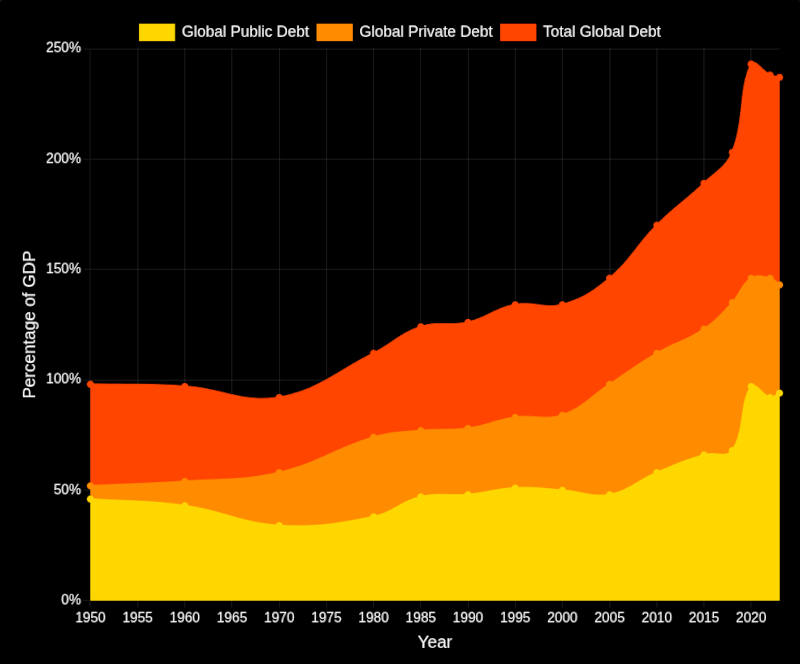
Bank of International Settlements. (2023, June 12). Debt Securities Statistics. Bank of International Settlements. Retrieved June 27th, 2025, from https://www.bis.org/statistics/secstats_to180923.htm
Campos, R. (2025, May 6). Global debt hits record of over $324 trillion, banking trade group says. Retrieved June 27th, 2025, from https://www.investing.com/news/stock-market-news/global-debt-hits-record-of-over-324-trillion-says-iif-4025097
Mbaye, S., Badia, M. M. M., & Chae, K. (2018). Global debt database: Methodology and sources. International Monetary Fund.
An Economy of Toxicants
Humans have created in excess of 150 000 novel chemicals or chemical mixtures during the last century. Estimates, based on a global inventory survey, suggest this figure could be as high as 350 000. This isn't a lot, it's a tsunami. If all the names of these chemicals were printed, not as lists, but side by side like ordinary words, they'd fill a book at least twice the size of the New Testament. Some substances undergo limited tests for possible adverse health effects, but most are not checked thoroughly. In fact, to test the effects of 150 000 substances, and all conceivable synergistic combinations of them, on just one single controlled factor, would be impossible. At a test rate of one trillion computations per second, it would take longer than the current age of the known universe, and more atoms than are estimated to exist in it. Plus, the human body isn't one single factor. Our genes have the potential to code for hundreds of thousands of distinct proteins. Post-translational modifications (changes made to the original protein) increase our capacity so we are capable of manufacturing a near infinite diversity of functional molecules. Additionally, we produce dozens of distinct hormones, and a host of other substances such as neurochemicals, lipids, and metabolites.
We're still at the tip of the iceberg when it comes to learning how the human body works, and we'll never extend our knowledge beyond a tiny fraction of potential interactions. Any innovation that seems beneficial in the short term could result in the catastrophic interference with the multitude of delicate and complicated processes that keep us alive and healthy. As we continually discover, we're often doing a great deal of harm with our fetish for novelty and glib disrespect for the enormous gap in our worldly knowledge. It's an immature approach to life.
Societies of Sickness & Denial
Rather than adopt a humble approach to life, many blame the sick for being sick, ignoring the tsunami of toxicants, and damaging social and physical environments that have been created without wise consideration. Similarly, people prefer to chastise those who raise the issue of a toxic economy, ignoring the mountain of public and private debt that has grown consistently, in real terms, since the late 1970s. For these people, their only reality is the one they choose to see. It helps them evade responsibility for their actions. That won't change anything. Defensive aggression won't stop anyone, including their loved ones, from becoming ill. It won't prevent a prolonged and miserable existence for millions suffering with chronic disease. It won't stop the debt-based pyramid scheme from collapsing. And it won't help people to help themselves.
An Economy of Self-Destruction
Overall, we've created a world with a lot more sick and suffering people. That's a fact. Given the incredible population increase over the last century, this is to be expected. Despite that, infectious diseases (nature's diseases) had reduced in prevalence, at least until recently; clean drinking water, soap, and sanitation being the main reasons. However, non-communicable diseases (NCDs) are becoming increasingly common. Many of these illnesses are caused, or exacerbated, by the never ending assault of novel factors our bodies have not evolved to deal with. These debilitating assaults reduce our capacity to cope with natural pathogens, too.
Additionally, many people seem ignorant of the fact that the brain is an organ. When it's damaged by toxins, or assaulted by electrosmog, it becomes dysfunctional. The brain, of course, is in charge of monitoring and regulating most bodily functions to some degree. When it goes wrong, almost any dysfunction can arise. The cause is biological, but symptoms can be experienced as low mood, confusion, fatigue, mood swings, headaches, insomnia, or similar. Much mental illness is likely due to physical affliction in the brain, but this possibility is mostly ignored. Blaming the individual, and labelling issues as 'psychological', avoids dealing with the challenges of reality. Such problems cannot be dealt with without significant and costly environmental and economic changes. It's easier to stick a label on a person, throw a handful of pills and some meditative exercises at them, and turn a blind eye to the depraved sickness of society.
An Economy with Increasing Returns of Physiological Harm
Allergies are increasing, more people suffer from autoimmune diseases, and obesity is a global crisis. Most alarming, for those who think the human species is worth continuing, is the plausible projection that male sperm counts could hit zero by 2045. That means no more people, and most of this infertility is caused by our own patterns of consumption and waste production. If you want to drive humankind to extinction, do nothing different. Work, consume, sleep. Stay busy, think less, and never fail to worship the virtue of economic growth. It might be the best thing. After all, if zero fertility doesn't happen, the people who survive will be increasingly sick, living lives with multiple chronic illnesses, facing more violent conflict, struggling in a crumbling, lawless society, and generally not having a particularly pleasant time. Extinction could be a better option.
Whose Economy Is It Really?
The economy is often treated like some quasi-sentient universal force with an insatiable appetite. If you don't continue to feed it ever-increasing amounts, it will turn on you, and harm you. But it isn't a being of its own accord. It isn't a universal law. Yet, the way it is framed and discussed in popular media infuses it with such qualities. This view means that adverts that sell emotional lies are normalized. And those people producing unnecessary objects and consumables, that harm people and the environment, are labelled successful, role models, and leaders. It's actually a pretty abysmal state of affairs because immorality hasn't just been ignored, it's been incentivized and celebrated for decades.
The stupid economy hasn't been organized to the disbenefit of everybody, though. If we look at the long-term trends, we can spot a pattern. Initially, it might seem obvious who has been on the take at the expense of everybody else. However, it's important to remember that there are microstructures behind what is going on that veil many significant beneficiaries. What is clear, is that ethics have been chucked out of the window, and that should speak volumes about those who were behind the changes, and those belligerently continuing along the same course.
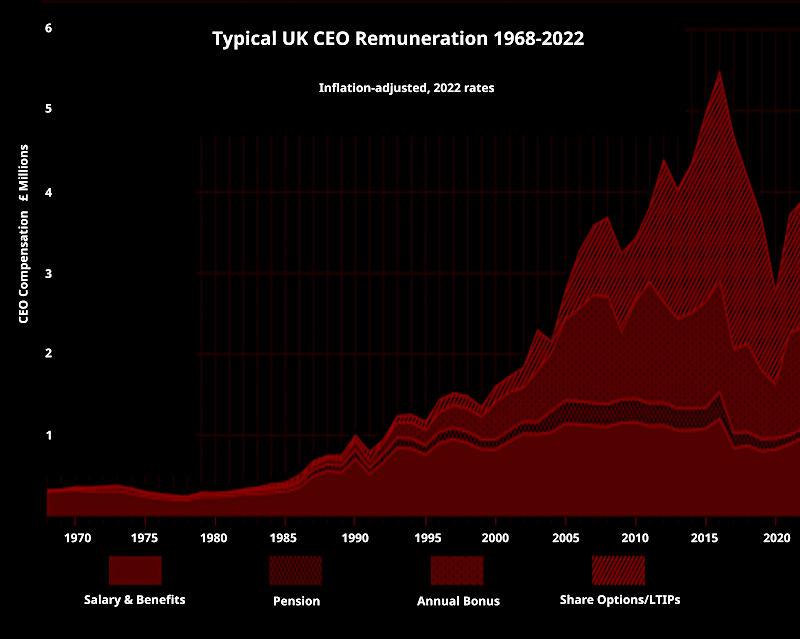
Source: Pepper, A. (2024). CEO pay in the United Kingdom, 1968–2022. Business History, 1-22.
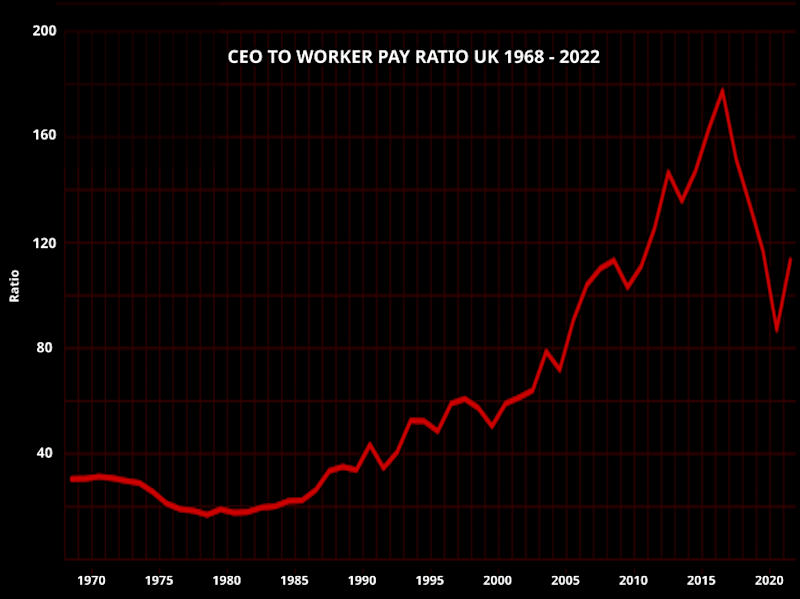
Source: Pepper, A. (2024). CEO pay in the United Kingdom, 1968–2022. Business History, 1-22.
If UK workers had received increases commensurate with those enjoyed by CEOs, pay and benefits packages would be around 4x higher than they are today. While real pay has increased slightly, the pattern is a continuing downward trend, commencing in the 1980s. The opposite as that for CEOs. Additionally, living costs, including those of basic needs such as water and accommodation, are now significantly higher in real terms than they were.
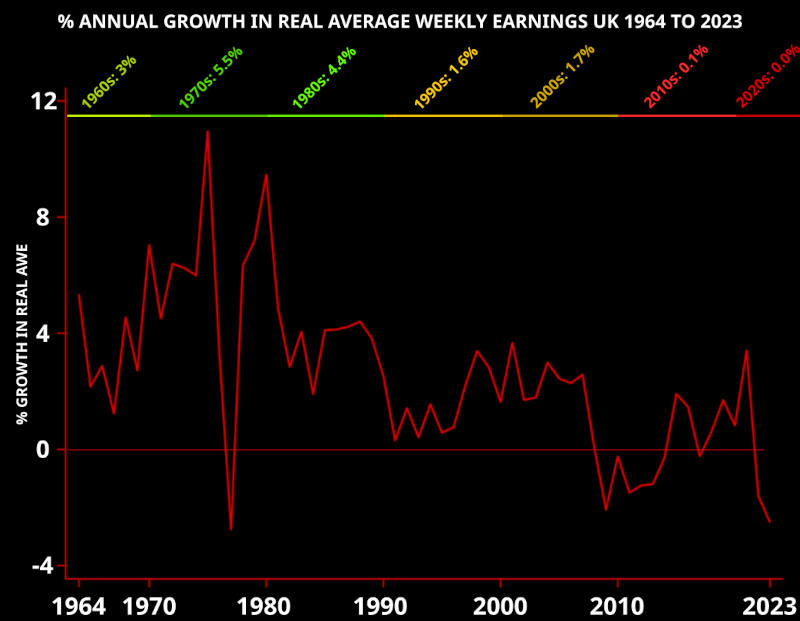
Source: Machin, S. (2024). Wage controversies: real wage stagnation, inequality and labour market institutions. LSE Public Policy Review, 3(2).
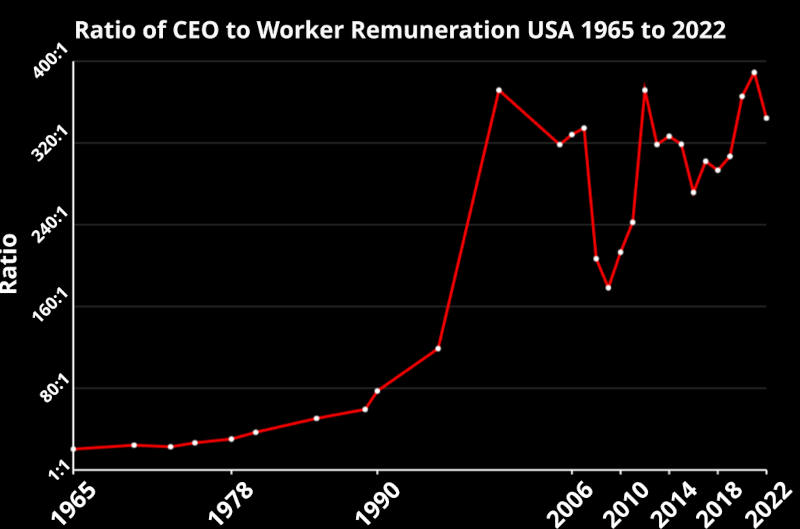
In the USA, the trends are even more extreme, with CEO pay and benefits rocketing to well over 300x the value of workers' rewards. Additionally, the federal minimum wage has steadily declined in real terms since 1968. Had minimum wage risen in correlation with productivity, it would now be over $25 per hour. Had it been pegged to the average CEO package value, it would be over $200 per hour.
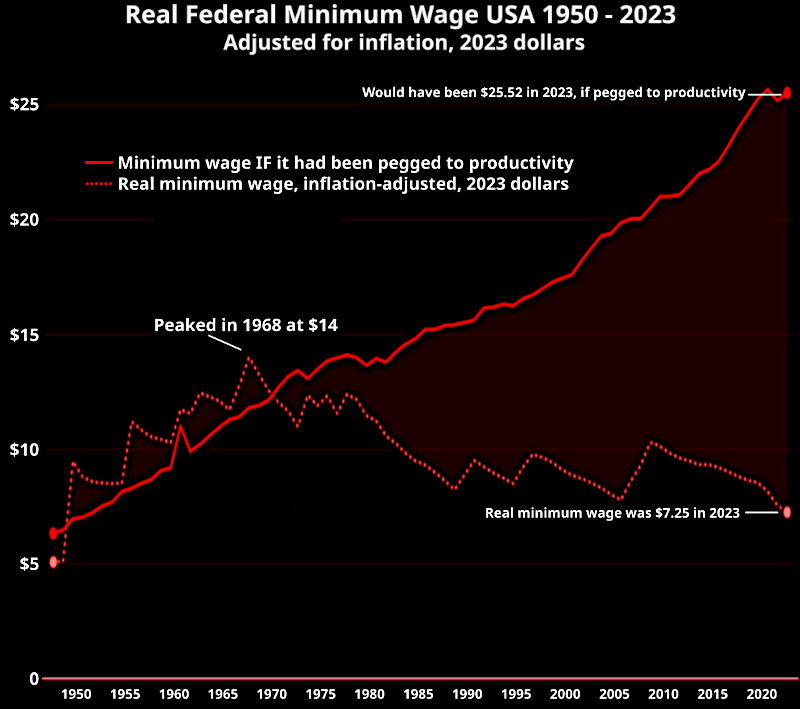
The growth in public debt, private debt, inequality, and environmental toxicity has been to the (temporary) benefit of some. Large minorities of those who have 'successfully' exploited the system for their own gain think everything is just fine and dandy, because it is for them. Half the world's wealth is held by the richest 1%; 85% by the richest 10%. That leaves 15% for the remaining 90% of people. This isn't the politics of envy, it's pointing out the pragmatic functioning of psychopathic tyranny. No ordinary person will ever be free under such a system. Those who think they are, suffer from Stockholm syndrome; a form of delusion instilled by the cult that has controlled their minds since birth.
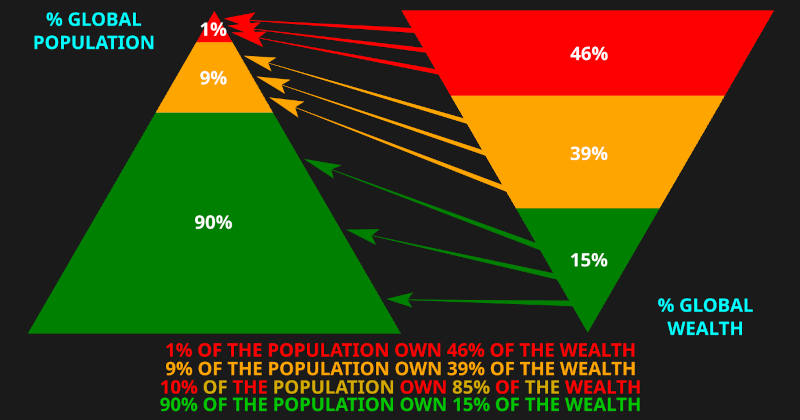
In terms of organizations, 69 of the top 100 of those holding the greatest capital are corporations, not governments. If you've never heard of BlackRock or Vanguard, you know nothing about the workings of the economic system. However, most of the richest people, and their families, will still suffer the consequences of the toxic treadmill. Maybe there are a few who might not. Those born into obscene privilege. Those who have clambered, fought, and oppressed others in their desperate, insatiable flight to the capstone. The ones building escape rockets, underground homes, panic rooms, and five star bunkers. When disaster strikes, the capstone, separate from the pyramid scheme, expects to remain floating, leaving those whom it was dependent on to suffer the aftermath. A mass of scapegoats, herded off a cliff, to pay for the sins of the elites.
The (post) modern Pharaohs and Pharisees
In the economic pyramid, those at the top consider themselves superior, perhaps of another race. They're reminiscent of biblical pharisees. The original meaning of pharisee was of a separated one, someone who believed themselves to be 'better' than the rest. However, they're not people of substance, but of show.

Interestingly, this separation is symbolized in the capstone of the pyramid scheme depicted on the dollar bill. The Latin phrases that appear with it, 'annuit coeptis' and 'e pleuribus unum', have similarly fascinating translations. Meaning 'our undertakings are favoured (by god)' and 'from many comes one', these phrases are often interpreted in the framework of nationalism or religious idealism. Everyone working for one goal. The common people contributing to, and benefitting from, the system. However, that view is contrary to the evidence, and fails to ask some simple questions. What god or superior value has truly been favoured? Why? What is this 'one' that comes from the many? Does it really arise for the benefit of the people, or perhaps at their cost? Do lower elements in a pyramid really have as good a time as those higher up, the weight of which they support at their own expense?
With AI positioned to replace the bulk of the pyramid, the capstone may indeed separate itself from dependency on the activity of the masses and float away. Much more symbolism is present on the dollar bill. It's fascinating to dissect, but more important is learning to see through the propaganda that normalized contemporary economic apartheid.
References
Butterworth, P., Watson, N., & Wooden, M. (2020). Trends in the prevalence of psychological distress over time: comparing results from longitudinal and repeated cross-sectional surveys. Frontiers in Psychiatry, 11, 595696.
Chen, D. M. C., Bodirsky, B. L., Krueger, T., Mishra, A., & Popp, A. (2020). The world’s growing municipal solid waste: trends and impacts. Environmental Research Letters, 15(7), 074021.
Collishaw, S. (2015). Annual research review: secular trends in child and adolescent mental health. Journal of Child Psychology and Psychiatry, 56(3), 370-393.
Cybulski, L., Ashcroft, D. M., Carr, M. J., Garg, S., Chew-Graham, C. A., Kapur, N., & Webb, R. T. (2021). Temporal trends in annual incidence rates for psychiatric disorders and self-harm among children and adolescents in the UK, 2003–2018. BMC psychiatry, 21, 1-12.
Dykxhoorn, J., Osborn, D., Walters, K., Kirkbride, J. B., Gnani, S., & Lazzarino, A. I. (2024). Temporal patterns in the recorded annual incidence of common mental disorders over two decades in the United Kingdom: a primary care cohort study. Psychological Medicine, 54(4), 663-674.
Fan, Y., Fan, A., Yang, Z., & Fan, D. (2025). Global burden of mental disorders in 204 countries and territories, 1990–2021: results from the global burden of disease study 2021. BMC psychiatry, 25(1), 486.
Monaco, A. P. (2021). An epigenetic, transgenerational model of increased mental health disorders in children, adolescents and young adults. European Journal of Human Genetics, 29(3), 387-395.
Swan, S. H., & Colino, S. (2022). Count down: how our modern world is threatening sperm counts, altering male and female reproductive development, and imperiling the future of the human race. Simon and Schuster.
Wu, Y., Wang, L., Tao, M., Cao, H., Yuan, H., Ye, M., ... & Zhu, C. (2023). Changing trends in the global burden of mental disorders from 1990 to 2019 and predicted levels in 25 years. Epidemiology and psychiatric sciences, 32, e63.